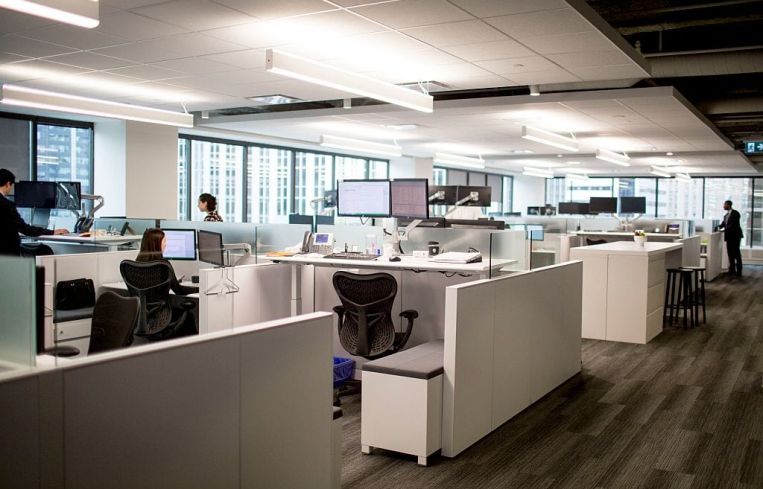Office Sector Will Face Tough Tests as the U.S. Reopens: Trepp
By The Editors June 9, 2021 5:45 pm
reprints
With the U.S. on track to fully reopen in the coming months and firms scrambling to figure out how to bring employees back to the physical workplace, the office segment seems to be the wild card for everyone in commercial real estate (CRE),” wrote Catherine Liu, an associate manager at research firm Trepp. “The key questions that must be answered during this transition process include the following: As employees increasingly see the benefits of remote work, how do we create an office environment that will be worth the commute? How will the configuration and spacing needs of offices change? What new sanitary and social distancing protocols will need to be implemented? How do we find the balance between allowing work flexibility and ensuring productivity?
How COVID Will Change the Office as We Know It
“While the pandemic was thought to have accelerated pre-COVID trends that had been playing out in CRE, the opposite was seen in the office sector, where de-densification and an exodus out of urban cores became the norm, driven by employees fleeing to the suburbs and relocating to areas with cheaper living costs.
“As the old ‘working from home is unproductive’ adage was proven false and firms prepare for employees to return to in-person work, it is apparent that COVID-19 will permanently change the way we interact with colleagues and the role that technology plays in how we do business going forward. Employers will continually shift away from the once-favored collaborative open floor plans and be tasked with optimizing office designs to maintain proper distancing and safety requirements while also being mindful of square-footage costs. This will likely give rise to new technologies aimed at managing densification patterns, cleaning procedures, and workstation usage.
“Issuers pulled back on the origination of retail and lodging loans after the sectors became the hardest hit by the pandemic and came under intense scrutiny, which led to increased exposure for seemingly ‘safer’ assets, like office, multifamily, and industrial in commercial mortgage-backed securities (CMBS) deals issued in 2020. Office new issues totaled $19.2 billion in 2020 and $10.3 billion in 2021 year-to-date (as of June), which amounts to roughly 34.8 percent and 33.2 percent of overall issuance for those two periods, respectively. The issuance is up significantly from a share of 21.2 percent and 26.8 percent in 2018 and 2019.
CMBS Issuance by Property Type
“The rise in distress rates across office subsectors was modest relative to that of lodging and retail. The long-term nature of office leases allowed borrowers to maintain debt service obligations even though physical occupancy dropped off significantly during the height of the pandemic. The overall office CMBS delinquency rate ticked up from 1.75 percent in March 2020 to 2.65 percent in June 2020 during peak delinquency percentages last year, the smallest increase among the five major property types for that time frame. The exception is industrial, which currently reports delinquencies that have dipped to below pre-pandemic levels. This compares to the 23 percent and 14 percent jumps in lodging and retail delinquency percentages, respectively, for the three-month period leading up to June 2020.
“As of April 2021, the delinquency rate for suburban office loans is slightly higher at 3.72 percent, above the 2.1 percent rate for all office assets, while only 1.6 percent of urban office loans are categorized as delinquent. Office special servicing rates also remain low at 2.82 percent as of April 2021. The property sector will face additional headwinds during the recovery process, however, with the full coronavirus impact on the office sector expected to take years to unfold and firms continuing to reevaluate their need for space once leases come up for renewal.
Office CMBS Delinquency Rates
“Though there is minimal distress for office loans reflected in servicer data, there are still recent signs of softening for the property type across major metropolitan areas. When examining the most recently reported occupancy rates on outstanding office loans between March 2020 and April 2021, notable occupancy declines were seen across the top 25 metropolitan areas with the largest CMBS exposure. In particular, the New York (-2.32 percent decline in occupancy); Minneapolis (-2.3 percent); Washington, D.C. (-2.27 percent); Houston (-2.22 percent); and Bridgeport and Stamford, Conn. (2.16 percent) metros rank among the top five with the largest occupancy losses. By property subtype, average office occupancy behind outstanding CMBS fell from 91.3 percent to 90.3 percent over the same time frame, while urban (-0.99 percent) and suburban office (-1.28 percent) occupancies dropped below 90 percent for the first time since 2018.
How Will the Office Look Post-Pandemic?
“As the U.S. plans for a complete reopening in the coming weeks and the office market recovery shifts into full swing, there will be many unknowns that will need to be addressed as the advantages of remote work and reduced business travel are adopted into the new office ‘normal.’ While the larger space inventory and the potential for lower demand due to hybrid work models will suppress re-absorption and keep a lid on asset values in the near term, concerns about the ‘death of the office’ or ‘death of gateway cities’ have largely been overblown. Younger employees jump-starting their careers still broadly prefer to engage with colleagues in-person, and major urban cores, boasting diverse amenity offerings and cultural attractions, will continue to attract top talent.”


